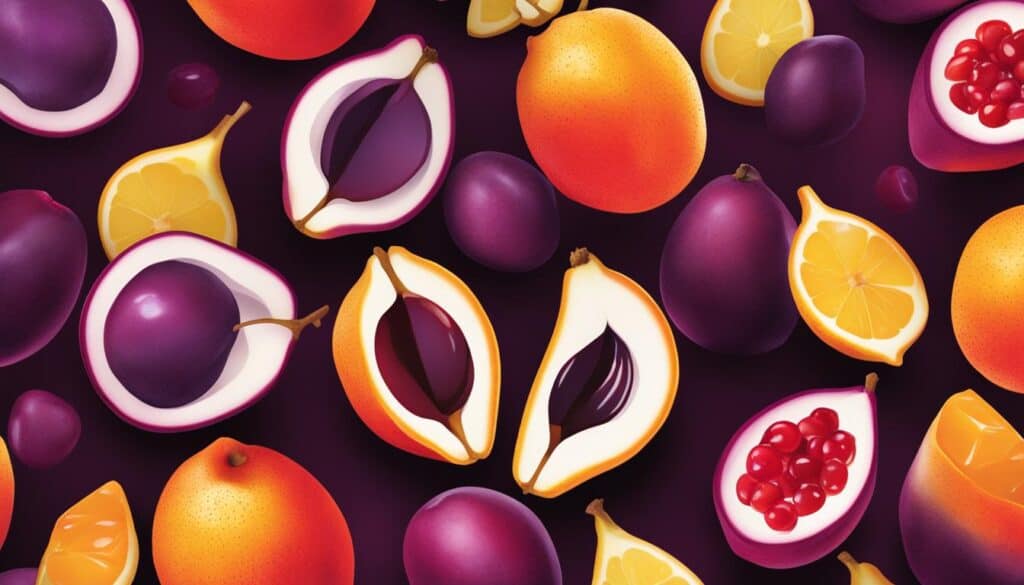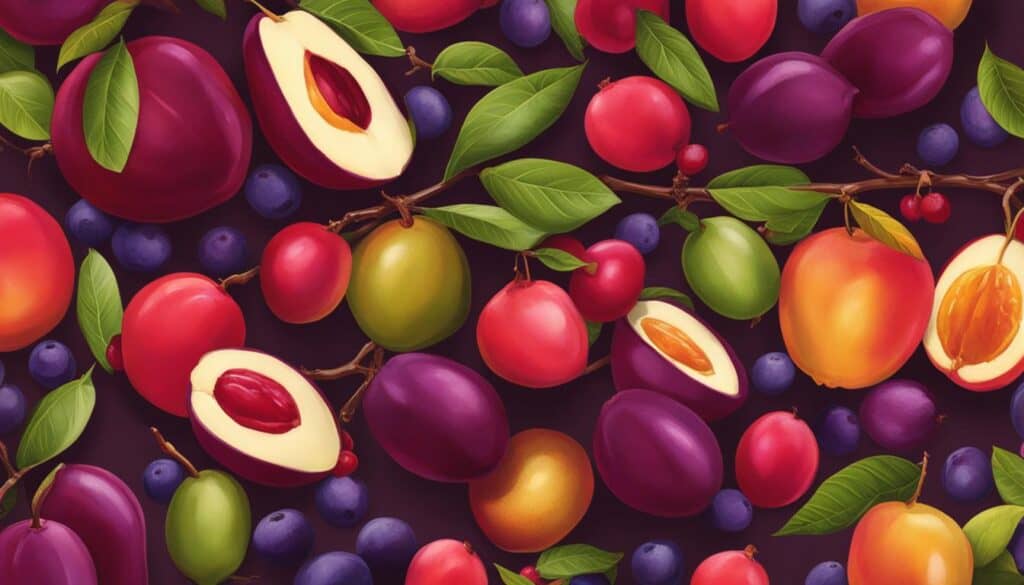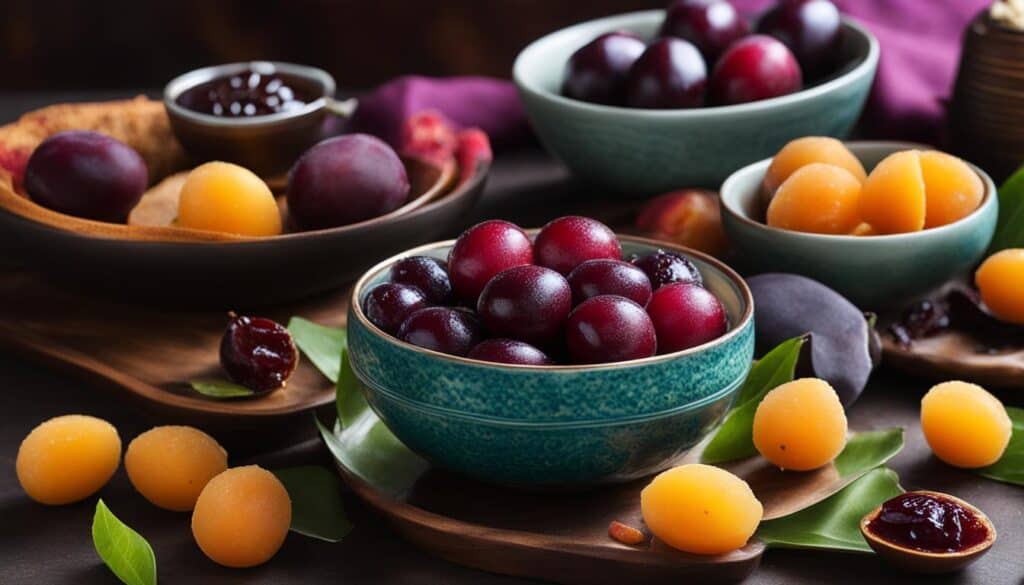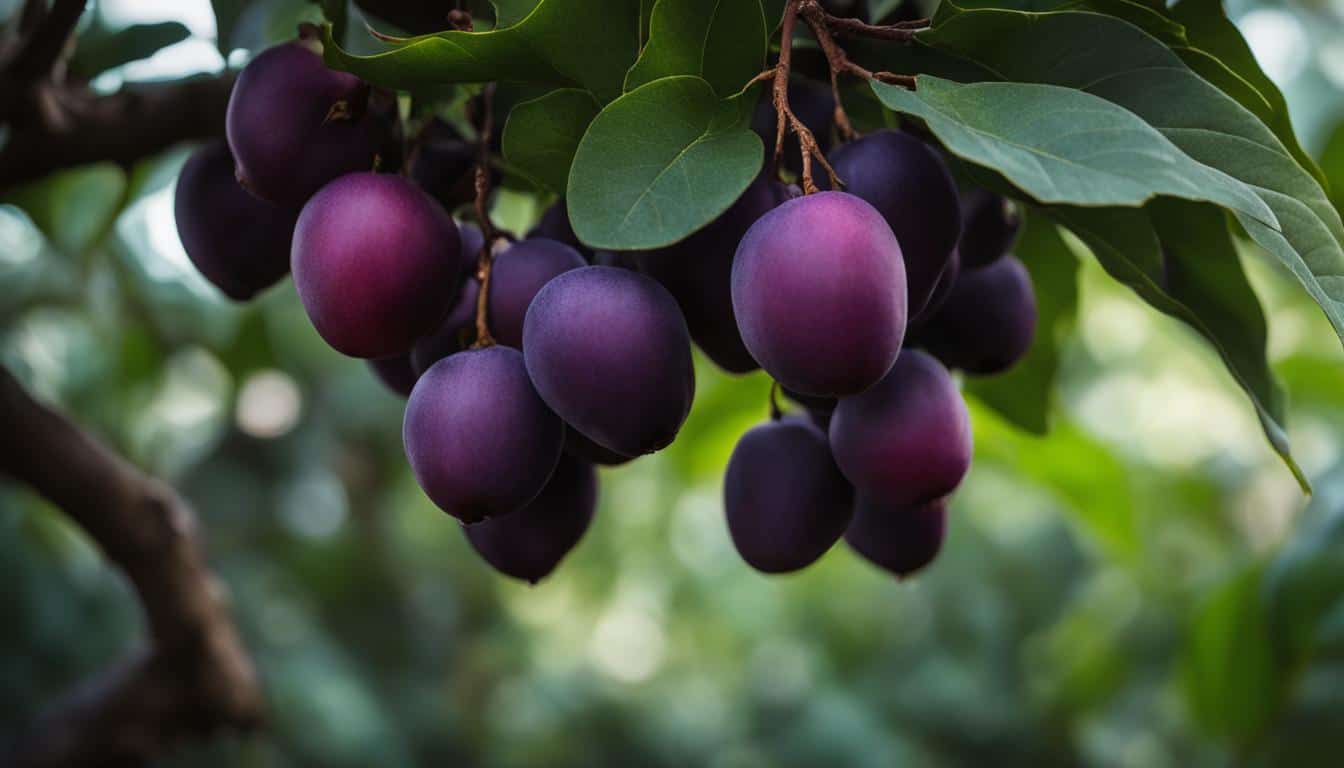Hey there! Today, I’m going to introduce you to the delightful and refreshing world of Java Plum. Have you ever wondered what this unique fruit is all about? Well, you’re in the right place! Allow me to share some fascinating information about Java Plum, also known as Jamun or Indian blackberry.
Native to the Indian subcontinent and commonly found in Asian countries, Java Plum is a tall tree with oblong fruits that turn pink or purple when ripe. Known for its sour taste and high water content, it’s a popular fruit in traditional medicine systems like Ayurveda, Unani, and Chinese medicine.
So, let’s dive into this journey together and explore the tastes and benefits of Java Plum, shall we?
Key Takeaways:
- Java Plum, also known as Jamun or Indian blackberry, is a refreshing fruit with many health benefits.
- It is native to the Indian subcontinent and commonly found in Asian countries.
- Java Plum has a sour taste and high water content, making it a popular choice in traditional medicine systems.
- Its Kapha and Pitta calming properties contribute to its significance in Ayurveda, Unani, and Chinese medicine.
- Stay tuned to discover more about the cultural, culinary, and medicinal aspects of Java Plum!
Reference of Java Plum in Hindu Scripture
Java plum, also known as Jamun, holds a significant reference in Hindu scripture, specifically the Ramayana. In this ancient epic, the fruit is referred to as the “Fruit of Gods.” According to the scripture, Lord Rama, the central character, consumed Jamun while he was in the forest for 14 years. This historical association adds to the cultural importance and reverence for the fruit in Indian society.
Moreover, Java plum is not only valued for its cultural significance but also for its various uses and benefits. Its distinctive flavor and nutritional properties make it a valuable fruit with diverse applications.
Java plum, also known as Jamun, holds a significant reference in Hindu scripture, specifically the Ramayana. In this ancient epic, the fruit is referred to as the “Fruit of Gods.” According to the scripture, Lord Rama, the central character, consumed Jamun while he was in the forest for 14 years. This historical association adds to the cultural importance and reverence for the fruit in Indian society.
Moreover, Java plum is not only valued for its cultural significance but also for its various uses and benefits. Its distinctive flavor and nutritional properties make it a valuable fruit with diverse applications.
Varieties of Java Plum
The Java plum, also known as Jamun or Indian blackberry, comes in two main varieties based on the color of its flesh. One variety has white-colored flesh, while the other has dark purple-colored flesh. The white-fleshed Java plum contains a high amount of pectin, a polysaccharide commonly found in fruits that is used as a thickening agent in jams and jellies. On the other hand, the dark purple-fleshed variety has a lower pectin content but an intense flavor and vibrant color.
Both varieties of Java plum can be used in various recipes to enjoy their unique flavors. The white-fleshed Java plum is great for making jams, jellies, and sauces due to its high pectin content. It can also be added to desserts like pies, cakes, and ice creams for a refreshing twist. The dark purple-fleshed Java plum is often enjoyed fresh, as its rich flavor and color make it a delightful snack on its own. It can also be used in fruit salads, smoothies, and cocktails to add a burst of sweetness and tanginess.
Whether you prefer the white or dark purple variety, incorporating Java plum into your recipes is a great way to explore its distinct taste and enjoy the numerous benefits it offers. From jams to salads, there are endless possibilities to experiment with this versatile fruit.
Comparison of White and Dark Purple-Fleshed Java Plum
| White-Fleshed Java Plum | Dark Purple-Fleshed Java Plum |
|---|---|
| High pectin content | Intense flavor and vibrant color |
| Ideal for making jams, jellies, and sauces | Enjoyed fresh or in fruit salads, smoothies, and cocktails |
| Used in desserts like pies, cakes, and ice creams | Refreshing snack on its own |
Both varieties of Java plum offer their own unique characteristics and can be enjoyed in a variety of dishes. Whether you’re a fan of the tangy sweetness of the white-fleshed Java plum or the rich flavor of the dark purple-fleshed variety, incorporating this versatile fruit into your recipes will surely add a delightful twist to your culinary creations.
Nutritional Value of Java Plum

Java plum, also known as Jamun or Indian blackberry, not only offers a delicious taste but also packs a nutritional punch. It is a low-fat fruit with a high water content, making it a refreshing and hydrating choice. Let’s take a closer look at the essential nutrients found in 100 grams of Java plum:
| Nutrient | Amount |
|---|---|
| Carbohydrates | 14 grams |
| Calories | 60 |
| Calcium | 12 mg |
| Potassium | 55 mg |
| Iron | 2 mg |
| Sodium | 26 mg |
In addition to these macronutrients and minerals, Java plum also contains vitamins like riboflavin and compounds similar to folic acid. These nutrients contribute to the various health benefits that Java plum offers.
The high water content in Java plum helps to keep you hydrated, while the carbohydrates provide energy. Calcium and potassium support healthy bone and muscle function, while iron aids in the production of red blood cells. The presence of riboflavin is essential for the conversion of food into energy, and compounds similar to folic acid are important for cell growth and development.
With its impressive nutritional profile, Java plum is a fruit that can be enjoyed as part of a well-balanced diet to support overall health and well-being.
Health Benefits of Java Plum
Java plum, also known as Jamun, offers numerous health benefits, making it a valuable addition to your diet. Particularly beneficial for women, this fruit has been praised for its therapeutic properties in traditional medicine systems and is a rich source of essential nutrients.
Jamun’s Benefits for Diabetes Management
One of the key health benefits of Java plum is its ability to help manage diabetes. The fruit has been shown to regulate blood sugar levels and improve insulin sensitivity, making it beneficial for individuals with diabetes. Its antidiabetic effects are attributed to compounds found in Jamun, such as jambosine and ellagic acid.
Enhanced Hemoglobin Levels
Java plum is also known for its ability to increase hemoglobin levels, making it particularly beneficial for women with anemia. The fruit contains iron and folic acid-like compounds, which contribute to the production of healthy red blood cells and help combat fatigue and weakness.
Supports Skin Health
When it comes to skincare, Java plum has got you covered. The fruit is known for its skin benefits, helping to treat various skin problems like acne and spots. Additionally, its high antioxidant content helps fight free radicals, preventing premature aging and promoting a healthy, glowing complexion.
Cardiovascular Support
Java plum boasts cardiovascular benefits as well. It helps lower bad cholesterol levels, reducing the risk of heart disease. The fruit’s antioxidant properties also help reduce oxidative stress, which can contribute to the development of cardiovascular conditions.
With its numerous health benefits, Java plum is a fruit that not only tantalizes your taste buds but also provides a range of advantages for your overall well-being.
Antidiabetic Effects of Jamun
Jamun, also known as Java plum, has been the subject of extensive studies due to its potential antidiabetic effects. Researchers have conducted experiments with rodents, revealing the antidiabetic properties present in various parts of the Jamun tree, including the seeds, fruit, and bark. These properties have shown promising results in lowering blood glucose levels, preventing hyperglycemia, and alleviating diabetic complications.
Studies have also suggested that Jamun may have antihyperglycemic action in humans with diabetes. These findings indicate that Jamun could be a valuable fruit for individuals managing diabetes or those at risk of developing the condition.
“Jamun has been found to lower blood glucose levels, prevent hyperglycemia, and alleviate diabetic complications.”
The antidiabetic effects of Jamun highlight its potential as a natural remedy for diabetes management. Further research is needed to explore the specific mechanisms behind these effects and to determine optimal usage and dosage for maximum benefits.
Nutrients in Jamun
| Nutrient | Quantity per 100g |
|---|---|
| Carbohydrates | 14g |
| Calcium | 12mg |
| Potassium | 55mg |
| Iron | 2mg |
| Sodium | 26mg |
Jamun is low in fat and high in water content, making it a refreshing and hydrating choice. It also contains vitamins like riboflavin and compounds similar to folic acid, contributing to its nutritional value.
The antidiabetic effects and nutritional value of Jamun make it a fruit worth incorporating into a balanced diet, especially for individuals with diabetes or those aiming to maintain healthy blood sugar levels.
Traditional Uses of Jamun

Jamun, also known as Java plum, has been an integral part of traditional medicine systems for centuries. Its various parts, including the fruits, seeds, bark, and leaves, are utilized for their medicinal properties in different cultures and medicinal systems. Here are some traditional uses of Jamun:
Ayurveda
In Ayurveda, the traditional Indian system of medicine, Jamun is considered beneficial for treating a range of health conditions. It is believed to have cooling and astringent properties, making it useful for alleviating symptoms of sore throat, bronchitis, and asthma. Jamun is also used in Ayurveda for its potential antidiabetic effects and is included in formulations aimed at managing diabetes mellitus.
Siddha and Unani
Siddha and Unani medicine systems, which originated in South India and the Middle East, respectively, also recognize the therapeutic properties of Jamun. In Siddha medicine, Jamun is considered a liver tonic and is used to improve liver function. Unani medicine utilizes Jamun for its dental benefits, as it is believed to strengthen teeth and gums. Additionally, both systems employ Jamun for its efficacy in treating various ailments and infections.
Homeopathy
Homeopathy, a system of alternative medicine, also utilizes Jamun for its healing properties. It is believed to have a positive effect on blood sugar levels, making it a potential remedy for individuals with diabetes. Homeopathic practitioners may prescribe Jamun-based remedies to help regulate blood glucose levels and alleviate associated symptoms.
These traditional uses of Jamun highlight its long-standing cultural significance and the recognition of its potential health benefits across different medicinal systems. While scientific research on its efficacy is ongoing, the historical use of Jamun in traditional medicine systems underscores its value as a natural remedy. It is important to note that consulting a qualified healthcare professional is recommended before using Jamun or any other natural remedy for medicinal purposes.
Phytochemistry of Jamun
Exploring the Nutritional Value and Health Benefits
The phytochemistry of Jamun, also known as Java plum, contributes to its nutritional value and numerous health benefits. This fruit, native to the Indian subcontinent, is rich in various compounds that support overall well-being. Let’s unravel the diverse phytochemical profile of Jamun and understand how it enhances its nutritional composition and health-promoting properties.
Phytochemicals are naturally occurring compounds found in plants that have been extensively studied for their potential health benefits. The stem bark of Jamun contains compounds such as friedelin, gallic acid, ellagic acid, and betulinic acid, which possess antioxidant and anti-inflammatory properties.
Research has shown that these compounds may help reduce inflammation, protect against oxidative stress, and support cardiovascular health.
The leaves of Jamun are a source of beta-sitosterol, crategolic acid, quercetin, and myricetin. Quercetin, in particular, is a flavonoid with antioxidant and anti-inflammatory effects that may help reduce the risk of chronic diseases, such as heart disease and certain types of cancer.
The pulp of Jamun is rich in anthocyanins, delphinidin, petunidin, and malvidin-diglucosides, which give the fruit its vibrant purple color. These compounds exhibit strong antioxidant activity, protecting cells from oxidative damage and promoting overall health.
In addition, Jamun seeds contain jambosine, corilagin, ellagic acid, and quercetin, which contribute to the fruit’s health benefits. These phytochemicals work together to provide Jamun with its unique nutritional profile and potential therapeutic effects.
By including Jamun in your diet, you can enjoy the goodness of these bioactive compounds and support your overall health and well-being. Whether consumed fresh, used in traditional recipes, or enjoyed as a part of culinary creations, Jamun offers a delightful sensory experience with its rich phytochemical content.
Harvest and Postharvest Conservation of Jamun
When it comes to harvesting Java plum, timing is crucial to ensure optimal fruit quality. The fruits are typically harvested when they are fully ripe and have attained their characteristic pink or purple color. At this stage, they are sweet and flavorful, making them ideal for consumption. However, since Jamun is a perishable fruit, proper postharvest conservation practices are necessary to prolong its shelf life and maintain its quality.
Refrigerated storage is commonly used for the preservation of Jamun. Maintaining a temperature of 8-10°C helps slow down the ripening process, preventing the fruits from becoming overripe and extending their shelf life. Additionally, controlling the relative humidity between 85-95% helps prevent moisture loss and maintain the fruits’ juicy texture.
In addition to refrigeration, the use of modified atmospheres can also be beneficial for the postharvest conservation of Jamun. Modified atmospheres involve altering the gas composition surrounding the fruits to create an ideal environment for storage. This technique can help delay the ripening process, reduce the activity of spoilage microorganisms, and minimize physiological disorders, ultimately prolonging the shelf life of Jamun fruits.
Table: Recommended Conditions for Postharvest Conservation of Jamun
| Storage Condition | Temperature (°C) | Relative Humidity (%) |
|---|---|---|
| Refrigeration | 8-10 | 85-95 |
| Modified Atmospheres | Varying gases and concentrations | Varying gases and concentrations |
By implementing these recommended storage conditions, farmers and distributors can minimize postharvest losses, reduce waste, and ensure the availability of high-quality Jamun fruits for consumers. Proper handling during harvesting and storage is essential to prevent bruising and damage, which can accelerate the fruit’s deterioration.
Overall, understanding the harvest and postharvest conservation techniques for Jamun is crucial for maximizing the fruit’s shelf life and maintaining its taste and nutritional benefits. These practices play a vital role in ensuring the availability of Java plum throughout the year, allowing consumers to enjoy its unique flavor and reap its health benefits.
Traditional Sweet and Wine Production from Jamun

Jamun, also known as Java plum, not only offers numerous health benefits but also plays a significant role in traditional sweet and wine production. In South Asian and Caribbean countries, Jamun is a key ingredient in the preparation of traditional sweets like gulab jamun and kala jamun. These delectable sweets are made by frying dough balls made from chhana (solidified milk) and soaking them in sugar syrup, infusing them with the distinct flavor and richness of Jamun. The natural sweetness and vibrant color of Jamun fruit make it an ideal choice for these traditional treats.
Moreover, Jamun fruit can also be used to create dry wines and high-quality alcoholic beverages. Regions like Goa in India and the Philippines are renowned for their Jamun-based wines and brandy production. The unique flavor profile of Jamun lends itself well to the fermentation process, resulting in exquisite wines with a hint of the fruit’s characteristic tanginess. The versatility of Jamun is truly showcased in its ability to enhance both sweet delicacies and sophisticated beverages, making it a treasured fruit in culinary traditions.
Traditional Sweet Recipes with Jamun:
- Gulab Jamun: A popular Indian sweet made by deep-frying dough balls soaked in rose-flavored sugar syrup.
- Kala Jamun: Similar to gulab jamun, but with a darker color and a richer flavor. It is often garnished with chopped pistachios.
- Jamun Burfi: A delightful milk-based sweet infused with Jamun pulp and flavored with cardamom and saffron.
Wine and Brandy Production with Jamun:
| Region | Wine/Brandy |
|---|---|
| Goa, India |
|
| The Philippines |
|
These traditional sweet recipes and wine production methods exemplify the versatility and cultural significance of Jamun. Whether indulging in the mouthwatering sweets or savoring the complex flavors of Jamun-based wines, one can truly appreciate the diverse applications and rich heritage associated with this remarkable fruit.
Historical Cultivation and Usage of Jamun

Jamun, also known as Java plum, has a fascinating history that spans centuries and is deeply rooted in the Indian subcontinent. The fruit is native to India, Myanmar, Sri Lanka, and the Andaman Islands, where it has been cultivated and cherished for generations. The Jamun tree requires a humid climate to thrive, and its fruits mature during the rainy season, making it an integral part of traditional agriculture in these regions.
The historical significance of Jamun extends beyond its cultivation. In Hindu scripture, particularly the Ramayana, the fruit is referred to as the “Fruit of Gods.” It is believed that Lord Rama, a revered figure in Hindu mythology, consumed Jamun during his exile in the forest. This connection to ancient mythology adds to the cultural importance and reverence for the fruit among Hindus.
Throughout history, Jamun has been valued not only for its cultural and religious significance but also for its medicinal properties. In traditional medicine systems like Ayurveda, Jamun has been used to treat various ailments such as sore throat, bronchitis, asthma, dysentery, and diabetes mellitus. Different parts of the Jamun tree, including the fruits, seeds, bark, and leaves, are utilized for their medicinal properties in different traditional systems such as Siddha, Unani, and Homeopathy.
Beyond its medicinal uses, Jamun has also found its way into various culinary traditions. The fruit is a popular ingredient in the preparation of traditional sweets like gulab jamun and kala jamun in South Asian and Caribbean countries. These delectable treats are made by frying dough balls made from chhana and soaking them in sugar syrup, resulting in a mouthwatering dessert. In regions like Goa and the Philippines, Jamun fruits are also used in wine and brandy production, adding their unique flavor and richness to these alcoholic beverages.
| Key Points |
|---|
| Java plum, also known as Jamun, has a rich history of cultivation and usage in the Indian subcontinent. |
| The fruit is native to India, Myanmar, Sri Lanka, and the Andaman Islands, where it has been cultivated for generations. |
| Jamun holds cultural and religious significance, with references in Hindu scripture, including the Ramayana. |
| In traditional medicine systems like Ayurveda, Jamun is used to treat various ailments, and different parts of the tree are utilized for their medicinal properties. |
| Jamun is also incorporated into culinary traditions, being used in the preparation of traditional sweets and alcoholic beverages. |
References:
- “Java Plum (Jamun) – Sydney Food and Nutrition Network.” Sydney Food and Nutrition Network, 12 Jan. 2022, www.sydneyfoodandnutritionnetwork.org.au/language/en-au/2020/05/01/java-plum-jamun/.
- Ram, Anuj Kumar, et al. “Syzygium cumini Against Diabetes and Associated Complications.” Journal of Complementary and Integrative Medicine, vol. 16, no. 4, 2018.
- Singh, Anju, and Om Prakash. “Pharmacognostical and Phytochemical Evaluation of Bark of Syzygium Cumini Linn.” International Journal of Pharmacy and Pharmaceutical Sciences, vol. 5, no. 1, 2013, pp. 142-145.
Conclusion
In conclusion, Java plum, also known as Jamun or Indian blackberry, is a fruit that offers a delightful taste and numerous health benefits. This versatile fruit holds cultural, medicinal, and culinary significance, making it a valuable addition to any diet.
From its reference in Hindu scripture to its traditional uses in various medicinal systems, Java plum has a long history of being valued for its properties. Its antidiabetic effects, nutritional value, and ability to support women’s health are particularly noteworthy.
Whether enjoyed fresh, used in traditional sweets, or utilized in beverage production, Java plum provides a delightful experience and potential health benefits. So, next time you come across this fruit, don’t hesitate to indulge in its unique flavors and reap its potential health benefits.
FAQ
What is Java Plum?
Java plum, also known as Jamun or Indian blackberry, is a delicious and refreshing fruit native to the Indian subcontinent and commonly found in Asian countries. It is a tall tree with oblong fruits that turn pink or purple when ripe, known for its sour taste and high water content.
What are the health benefits of Java Plum?
Java plum offers numerous health benefits, particularly for women. It helps in treating symptoms of diabetes, increases hemoglobin levels, treats skin problems like acne and spots, strengthens teeth and gums, and has cardiovascular benefits by reducing bad cholesterol and oxidative stress.
What are the nutritional values of Java Plum?
Consuming 100 grams of Java plum provides approximately 14 grams of carbohydrates, 60 calories, 12 mg of calcium, 55 mg of potassium, 2 mg of iron, and 26 mg of sodium. It also contains vitamins like riboflavin and compounds similar to folic acid, contributing to its nutritional value.
What are the antidiabetic effects of Jamun?
Jamun, also known as Java plum, has been extensively studied for its antidiabetic effects. It has been found to lower blood glucose levels, prevent hyperglycemia, and alleviate diabetic complications. Some studies also suggest that Jamun may have antihyperglycemic action in humans with diabetes.
What are the traditional uses of Jamun?
In traditional medicine systems like Ayurveda, Unani, and Chinese medicine, Jamun is considered beneficial for treating sore throat, bronchitis, asthma, dysentery, and diabetes mellitus. It is also recognized for its liver tonic properties, ability to strengthen teeth and gums, and efficacy in treating various ailments and infections.
What are the phytochemicals found in Jamun?
Jamun has a diverse phytochemical profile, with different parts of the tree containing various compounds. The stem bark contains friedelin, gallic acid, ellagic acid, and betulinic acid. The leaves contain beta-sitosterol, crategolic acid, quercetin, and myricetin. The flowers contain oleanolic acid, ellagic acid, and various flavonols. The pulp of Jamun is rich in anthocyanins, delphinidin, petunidin, and malvidin-diglucosides. The seeds contain jambosine, corilagin, ellagic acid, and quercetin.
How can the shelf life of Jamun be extended?
Jamun is considered a perishable fruit and requires special care during harvesting and postharvest conservation. Refrigerated storage, moisture control, and the use of modified atmospheres are common practices that can help prolong its shelf life. Proper handling and conservation techniques are essential to reduce waste and ensure the availability of high-quality Jamun fruits.
How is Jamun used in culinary applications?
Jamun is not only enjoyed as a fresh fruit but also used in traditional sweet and wine production. In South Asian and Caribbean countries, Jamun is used in the preparation of traditional sweets like gulab jamun and kala jamun. It can also be used to make dry wines and high-quality alcoholic beverages, particularly in regions like Goa and the Philippines.
What is the historical cultivation and usage of Jamun?
Jamun is native to India, Myanmar, Sri Lanka, and the Andaman Islands and has spread to other parts of Asia, Eastern Africa, and the United States. It has been cultivated and used for its medicinal properties, including its antidiabetic effects, in various traditional and folk systems of medicine. It is also valued for its culinary uses and is an important ingredient in traditional sweets, wines, and alcoholic beverages.





Leave a Reply